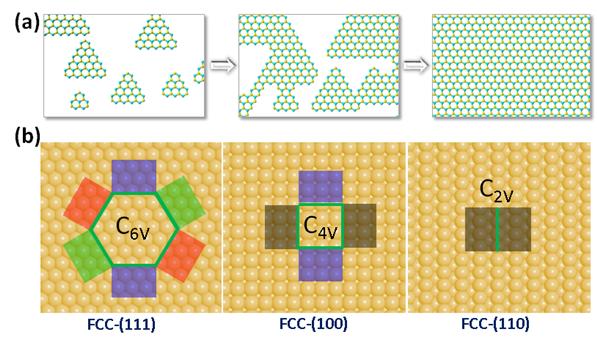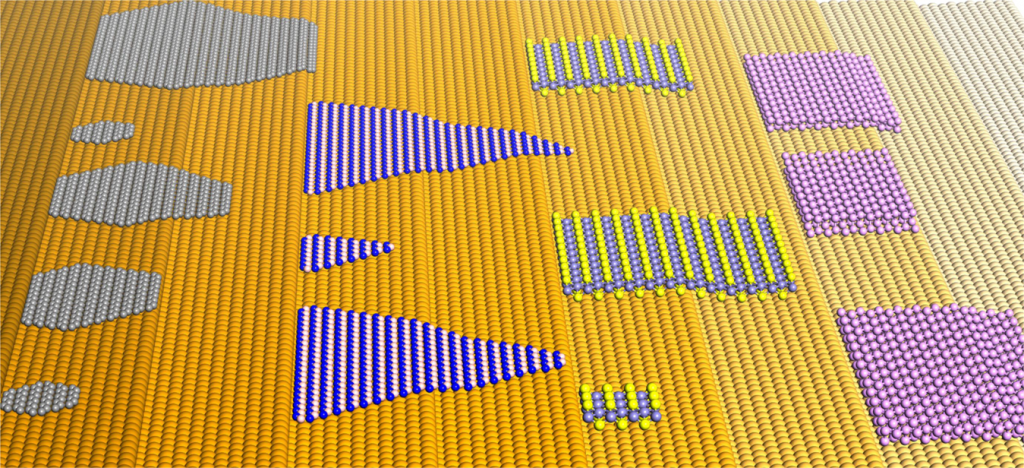Two-dimensional (2D) nanomaterials, such as graphene, hexagonal boron nitride, and molybdenum disulfide, hold great potential for building next-generation high-performance electronics. To realize the maximized performance of the 2D materials in electronic applications, high-quality samples of various 2D materials, ideally large films of 2D single crystals, are highly desired. In the past ten years, material scientists all over the world dedicated great efforts to the synthesis of large-area 2D single crystals, and substantial progress has been made, such as the synthesis of wafer-scale single crystals of graphene and hexagonal boron nitride has been realized recently. While a general strategy that allows the synthesis of various 2D single crystals is still lacking.
Currently, the approach to grow a large number of uniformly aligned islands of a 2D material on a substrate and then seamlessly stitch them into a large single crystal, which is called epitaxial growth (See Figure 1), is the most promising method towards the synthesis of various 2D single crystals. The key towards the success of the epitaxial growth of a 2D single crystal is realizing the uniform alignments of millions of 2D islands on a large area substrate and tremendous experimental efforts have proved that it is very difficult to choose a proper substrate to realize the epitaxial growth of a 2D material.

Figure 1. The epitaxy of 2D materials growth.
Recently, Distinguished Professor Feng Ding and his colleagues from the Center for Multidimensional Carbon Materials (CMCM), within the Institute for Basic Science (IBS) at UNIST, proposed a general strategy towards the epitaxial growth of various 2D single crystals—by using substrates with high index surfaces. In the study, the authors firstly considered the interaction between a 2D material and a substrate by using the state-of-the-art computational approach and they have confirmed that a 2D material always tends to align along a high symmetry direction of the substrate. While, if the substrate has a high symmetry, the 2D material may have a few equivalent alignments on the substrate, as have been broadly observed experimentally. As a consequence of the theory of 2D material’s epitaxial growth, the authors concluded that a 2D material may have only one preferential alignment on a substrate with low symmetry and they propose that the uniform alignments of a large number of 2D islands might be easily realized on substrates with low symmetry.
Based on the theory, the authors have shown a map of the equivalent alignment of various 2D materials on various substrates and, after careful comparison with existing experimental results, they have found that the theory agrees perfectly with most of them.

Figure 2. Schematics showing well-aligned 2D materials (from left to right are graphene, hBN, FeSe and black phosphorene, respectively.) on a vicinal fcc(111) surface.
In most previous experimental studies, the commercially accessible high symmetry substrates, or substrates with low-index surfaces, are broadly used. While the authors suggest we should try a new class of substrates, namely substrates with high-index-surfaces, to realize the epitaxial growth of 2D single crystals (Figure 3). A high-index-surface generally has a large number of parallel atomic step edges and, during the 2D materials growth, these step edges can facility the nucleation and alignment of the 2D islands to ensure their uniformed alignments on the whole substrate. “Most previous experimental studies chose to use substrates with high symmetries, which are easily accessible in the market, while our theory showed that it is a wrong direction for the pursuing of 2D single crystals,” said Dr. Dong.
“We carefully compared with all the existing experimental results of 2D materials synthesis, and it is amazing that the simple theory agrees with all of them perfectly. So, the theory provides a general guideline for the synthesis of various 2D single crystals,” Professor Ding summarized “And with the guidance of the theory, the experimental scientists should be able to synthesize various 2D single crystals for the exciting applications soon.”
The findings of this research have been published in the online version of Nature Communications on November 17, 2020. This study has been supported by the Institute for Basic Science (IBS), South Korea.
Journal Reference
Jichen Dong, Leining Zhang, Xinyue Dai, Feng Ding, “The epitaxy of 2D materials growth,” Nature Communications, (2020).














